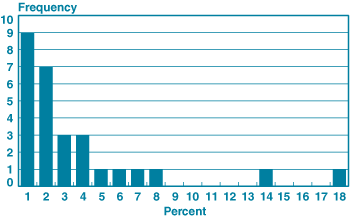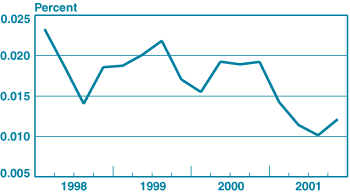Economic Policy Review Executive Summary
What Market Risk Capital Reporting Tells Us about Bank Risk
| Recapping an article from the September 2003 issue |
|
||
| of the Economic Policy Review, Volume 9, Number 3 | View full article |
||
|
|
18 pages / 183 kb | ||
|
Author: Beverly J. Hirtle |
Disclaimer | ||
| Index of executive summaries |
|
Overview The author investigates whether the capital amounts held by banks to cover the market risks in their trading portfolios—amounts disclosed in publicly available regulatory reports—provide important new information about the risk exposures of these institutions. She finds that while the capital figures add little to market participants' understanding of differences in risk across institutions, they do shed light on the evolution of individual institutions' risk exposures over time. In particular, changes in an institution's capital charges appear to be a strong predictor of changes in the volatility of its future trading revenue. Background Since 1998, U.S. bank holding companies with large trading operations have been required to hold capital sufficient to cover their market risk—the risk of loss from adverse movements in financial rates and prices. Institutions subject to this standard must disclose the amount of their capital charge in reports that are filed with the Federal Reserve and subsequently made available to the public. The aim of Hirtle's analysis is to determine whether these market risk capital disclosures capture information about the extent of the institutions' exposure that is not available from other data contained in regulatory reports. Discussion The author begins her analysis by assessing the importance of banks' market risk capital charge relative to the total risk capital that regulators require banks to hold. The total capital requirement, the author explains, equals the sum of a bank's requirements for market risk and credit risk. Hirtle finds that regulatory capital for market risk represents a small share of the overall amount of regulatory capital—less than 5 percent on average for most banks subject to the market risk requirements (chart). Her calculations suggest that this share has remained fairly constant over time (chart). Hirtle opens the next phase of her analysis with the observation that the market risk capital charges reported by the banks must meet two criteria to be useful indicators of risk exposure. Specifically, the capital charges must provide information that is both new—that is, not ascertainable from other regulatory report data—and accurate. To establish whether the capital figures satisfy the first criterion, the author assesses their correlation with a broad measure of risk exposure disclosed in the regulatory reports—the size of the banks' trading accounts. If variations in market risk capital across banks and over time are not highly correlated with variations in the size of the banks' trading accounts, she argues, the capital figures may contain some information beyond what is already conveyed by trading account size. Although the author's statistical tests show considerable correlation between these variables across banks, they provide some preliminary evidence that the capital figures contain new information about changes in individual institutions' risk over time. To determine whether the market risk capital figures meet the second criterion—that is, whether they provide accurate information about banks' risk exposures—Hirtle assesses the correlation between the figures and an independent measure of market risk, namely, banks' daily trading profits and losses. Specifically, the author tests the correlation between end-of-quarter market risk capital figures and daily profit and loss figures for the following quarter. This approach reveals whether shifts in the market risk capital figures can predict the variability of banks' future trading revenues. The results of these tests confirm that the capital figures provide little information about differences in market risk exposure across institutions beyond what is conveyed by the size of the trading account. Significantly, however, the tests do show a positive and statistically significant correlation between market risk capital and future trading profits and losses for individual institutions over time. Thus, market risk capital does appear to provide reliable forward-looking information about the evolution of individual banks' market risk exposures. Findings |
|
|
|
|
|
|
| Distribution of Bank Holding Companies by Average Market Risk Capital Share | |
 |
|
| Source: Federal Reserve FR Y-9C Reports. | |
|
|
| Median Market Risk Capital Share | |
 |
|
| Source: Federal Reserve FR Y-9C Reports. | |
|
|
|
By continuing to use our site, you agree to our Terms of Use and Privacy Statement. You can learn more about how we use cookies by reviewing our Privacy Statement. 










